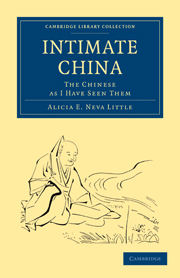Book contents
- Frontmatter
- Contents
- LIST OF ILLUSTRATIONS
- DRY STATEMENTS
- PRELUDE: FIRST IMPRESSIONS
- CHAPTER I ON THE UPPER YANGTSE
- CHAPTER II A LAND JOURNEY
- CHAPTER III LIFE IN A CHINESE CITY
- CHAPTER IV HINDRANCES AND ANNOYANCES
- CHAPTER V CURRENT COIN IN CHINA
- CHAPTER VI FOOTBINDING
- CHAPTER VII ANTI-FOOTBINDING
- CHAPTER VIII THE POSITION OF WOMEN
- CHAPTER IX BIRTHS, DEATHS, AND MARRIAGES
- CHAPTER X CHINESE MORALS
- CHAPTER XI SUPERSTITIONS
- CHAPTER XII OUR MISSIONARIES
- CHAPTER XIII UP-COUNTRY SHOPPING AND UP-COUNTRY WAYS
- CHAPTER XIV SOLDIERS
- CHAPTER XV CHINESE STUDENTS
- CHAPTER XVI A FATHER'S ADVICE TO HIS SON
- CHAPTER XVII BUDDHIST MONASTERIES
- CHAPTER XVIII A CHINESE ORDINATION
- CHAPTER XIX THE SACRED MOUNTAIN OF OMI
- CHAPTER XX CHINESE SENTIMENT
- CHAPTER XXI A SUMMER TRIP TO CHINESE TIBET
- CHAPTER XXII ARTS AND INDUSTRIES
- CHAPTER XXIII A LITTLE PEKING PUG
- PRELUDE: PART I.—GETTING TO PEKING and PART II.—THE SIGHTS OF PEKING
- CHAPTER I THE CHINESE EMPEROR'S MAGNIFICENCE
- CHAPTER II THE EMPRESS, THE EMPEROR, AND THE AUDIENCE
- CHAPTER III SOLIDARITY, CO-OPERATION, AND IMPERIAL FEDERATION
- CHAPTER IV BEGINNINGS OF REFORM
- CHAPTER V THE COUP D'ÉTAT
CHAPTER XXII - ARTS AND INDUSTRIES
Published online by Cambridge University Press: 05 March 2012
- Frontmatter
- Contents
- LIST OF ILLUSTRATIONS
- DRY STATEMENTS
- PRELUDE: FIRST IMPRESSIONS
- CHAPTER I ON THE UPPER YANGTSE
- CHAPTER II A LAND JOURNEY
- CHAPTER III LIFE IN A CHINESE CITY
- CHAPTER IV HINDRANCES AND ANNOYANCES
- CHAPTER V CURRENT COIN IN CHINA
- CHAPTER VI FOOTBINDING
- CHAPTER VII ANTI-FOOTBINDING
- CHAPTER VIII THE POSITION OF WOMEN
- CHAPTER IX BIRTHS, DEATHS, AND MARRIAGES
- CHAPTER X CHINESE MORALS
- CHAPTER XI SUPERSTITIONS
- CHAPTER XII OUR MISSIONARIES
- CHAPTER XIII UP-COUNTRY SHOPPING AND UP-COUNTRY WAYS
- CHAPTER XIV SOLDIERS
- CHAPTER XV CHINESE STUDENTS
- CHAPTER XVI A FATHER'S ADVICE TO HIS SON
- CHAPTER XVII BUDDHIST MONASTERIES
- CHAPTER XVIII A CHINESE ORDINATION
- CHAPTER XIX THE SACRED MOUNTAIN OF OMI
- CHAPTER XX CHINESE SENTIMENT
- CHAPTER XXI A SUMMER TRIP TO CHINESE TIBET
- CHAPTER XXII ARTS AND INDUSTRIES
- CHAPTER XXIII A LITTLE PEKING PUG
- PRELUDE: PART I.—GETTING TO PEKING and PART II.—THE SIGHTS OF PEKING
- CHAPTER I THE CHINESE EMPEROR'S MAGNIFICENCE
- CHAPTER II THE EMPRESS, THE EMPEROR, AND THE AUDIENCE
- CHAPTER III SOLIDARITY, CO-OPERATION, AND IMPERIAL FEDERATION
- CHAPTER IV BEGINNINGS OF REFORM
- CHAPTER V THE COUP D'ÉTAT
Summary
Even if I had the knowledge, it would be useless to attempt to write exhaustively of Chinese porcelain in one chapter; but a few shreds of information about it may be new to the general reader. Julien's theory that it was first made between the years 185 b.c. and a.d. 87 is set aside by Dr. Hirth, the greatest living authority upon ancient Chinese porcelain. The latter believes it was first made during the T'ang Dynasty, which lasted to a.d. 907; but there are no specimens of porcelain extant before the Sung Dynasty, which ended in 1259, the majority even then being of the class known as “celadons,” which survived owing to their thickness and strength. The prevailing colour of these celadons is green, the colour of jade; and yellow is mentioned as one of the ingredients used for producing this colour. They were mostly made in the south-west of the province of Chekiang, taken by river to the Amoy waters, and thence distributed by Arab traders to Japan, Borneo, sumatra, the west of Asia, and the east coast of Africa, in which last, curiously enough, large numbers have been discovered. They have been freely imitated at King-teh-chen, the great porcelain factory of China, as well as in Japan; but collectors should, it seems, have no difficulty in distinguishing the genuine articles, from their extreme hardness.
- Type
- Chapter
- Information
- Intimate ChinaThe Chinese as I Have Seen Them, pp. 425 - 445Publisher: Cambridge University PressPrint publication year: 2010First published in: 1899



